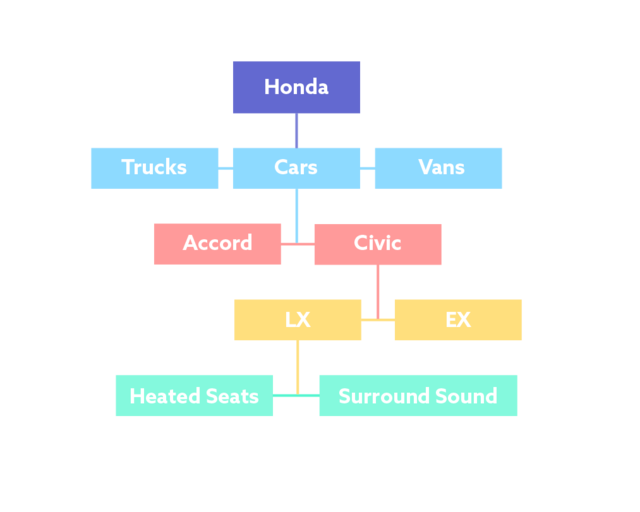
How to Make a Product Hierarchy that Scales
A product hierarchy is a model of your business’s offerings in an organized and logical structure. You’re likely most familiar with these constructs as they exist in merchandising and retail (Winter Wear → Women’s → Jackets → Down Jackets → Red), but they are equally as important and valuable in the arena of digital products.
Too often, tech companies market themselves based on their features. Moreover, the features they choose to highlight are baseline product expectations like “data protection” or “profile customization.” This granularity is misleading and dissatisfying to potential buyers because the product is almost always more capable than its marketing suggests. Imagine a realtor trying to sell you on a home’s 40 electrical outlets before mentioning its three bedrooms and two bathrooms. Odd, right?
The graphics below illustrate the parallel between physical product hierarchies and digital ones.
Here is an example for physical product hierarchy, Honda:

Here is an example for digital product hierarchy, Adobe:

In the same way retail items can be neatly grouped into systematic categories, so too can the modules and features of your business. It’s an important step toward product clarity.
An effective product hierarchy establishes a shared language across your organization.
Your product hierarchy helps representatives from every department speak confidently and consistently about what your product does, who it serves, and the ultimate value(s) delivered to the customer.
The dangers of a poorly organized product stretch far beyond digital walls and could negatively impact every corner of your business. Without a common language, you run the risk of misrepresenting product value, confusing potential buyers, or chasing unnecessary features.
Step 1: Establishing Your Root
It’s imperative to root your product hierarchy in user needs and business value. This shared root encourages methodical product growth as you continue adding new product lines, services, and features. If a new idea doesn’t serve the “root system” you’ve established, it likely won’t fit naturally into your product hierarchy. It can be difficult prioritizing “good” features over “great” ones just because the latter doesn’t fit the construct, but it will protect you from creating a “Frankenstein product” of disjointed functionality.
It’s imperative to root your product hierarchy in user needs and business value.
Product management is a direct line to user needs, so work with them to identify the proper root for your hierarchy. In the most generic sense, what are you solving for the user? Dropbox roots their entire product in team collaboration, and everything they do serves that goal.
Step 2: Organizing Your Features
Drafting a product hierarchy is not unlike organizing your closet, pantry, or garage, and it can be as simple or as sophisticated as you need. Keep in mind, however, that even large businesses can succinctly convey complex product ecosystems, so don’t shy away from simplification if that’s the natural output. It’s probably correct.
Start by identifying shared features and functionality, and categorize them by what pain(s) they solve. Consider Facebook: the Messenger and Video Chat products both fit under the shared umbrella of communication. Features like Suggested Connections and News Feed are all about discovery.
Buckets of functionality should be logical groupings that match the way the end product is ultimately presented and sold to the customer. This doesn’t just help internal sales talk about your product; it helps customers talk about your product, too.
Step 3: Growing Your Hierarchy
The earlier you design your product hierarchy, the better off you’ll be moving forward. Features are easier to vet and prioritize, packaging options emerge, and road-mapping exercises become less challenging.
Revisit your product hierarchy each time you grow your product to ensure new additions fit. If they don’t, that feature or product might now be worth pursuing, or you might consider creating a new category. A word of caution: New categories should only be created if they align to a roadmap of growth in that category. Don’t just create a new category to fit something because it doesn’t fit anywhere else.
Revisit your product hierarchy each time you grow your product to ensure new additions fit.
Ask yourself these questions each time you add new features or products:
- Does this feature/product fit naturally into an existing category in my hierarchy?
- Is it rooted in user needs and business goals?
- Will adding it affect my product positioning?
- Will adding it change the way we sell?
Using Your Product Hierarchy
Let your product hierarchy be your guide, and reference it regularly throughout your product journey.
Most importantly, don’t hide it.
It’ll help sales reps understand how to talk about the product, how to classify opportunities, how to upsell, and how to measure success. It’ll make it easier for marketing to structure release messaging, notes, and communications externally so users understand what’s new.
Publicize it internally, and departments across your business will feel more empowered to speak intelligently about the product. Publicize it externally, and customers will purchase more confidently, drive warmer word-of-mouth referrals, and enjoy a better product experience.
Follow The North Star
The North Star was a reliable source of direction before compasses and GPS, and even though it moves across the sky as the earth orbits the sun, it always stays due north.
In the same way, your product hierarchy will evolve as your business changes, but it should always remain your guiding light. Your North Star.
Trust in your product hierarchy and your product will grow effortlessly.



